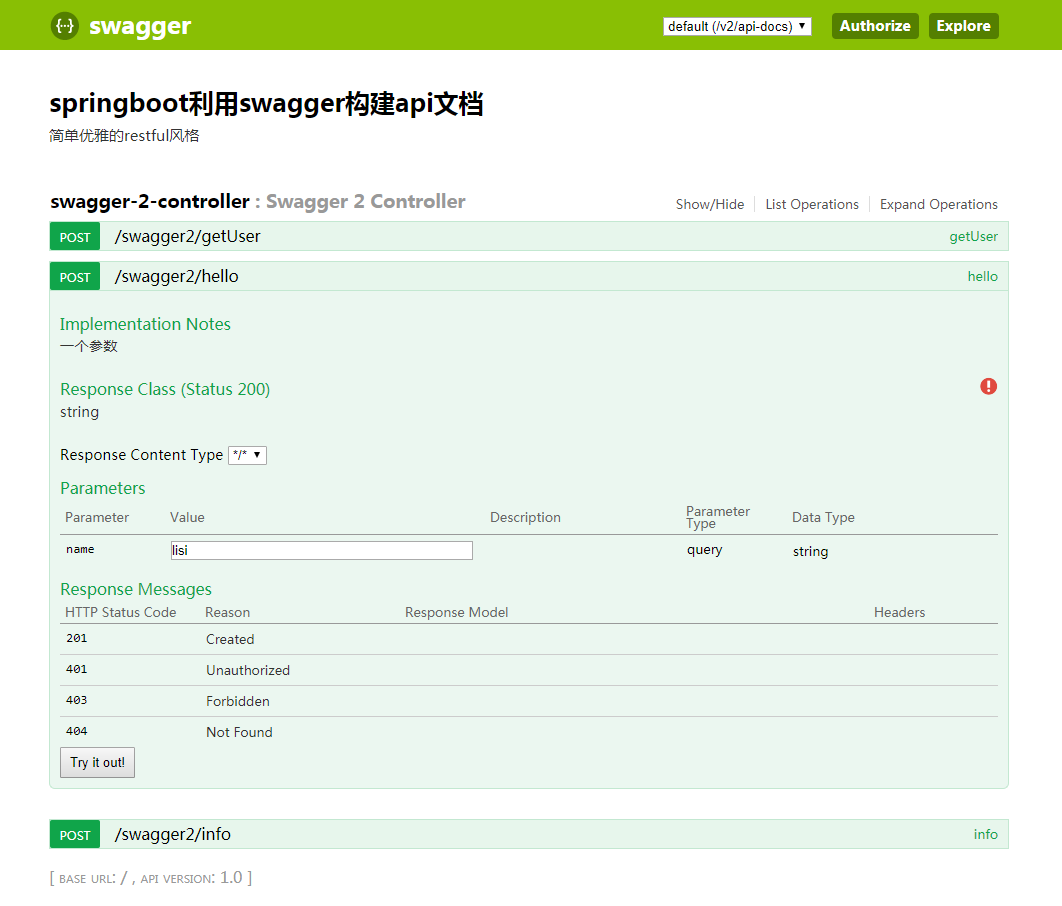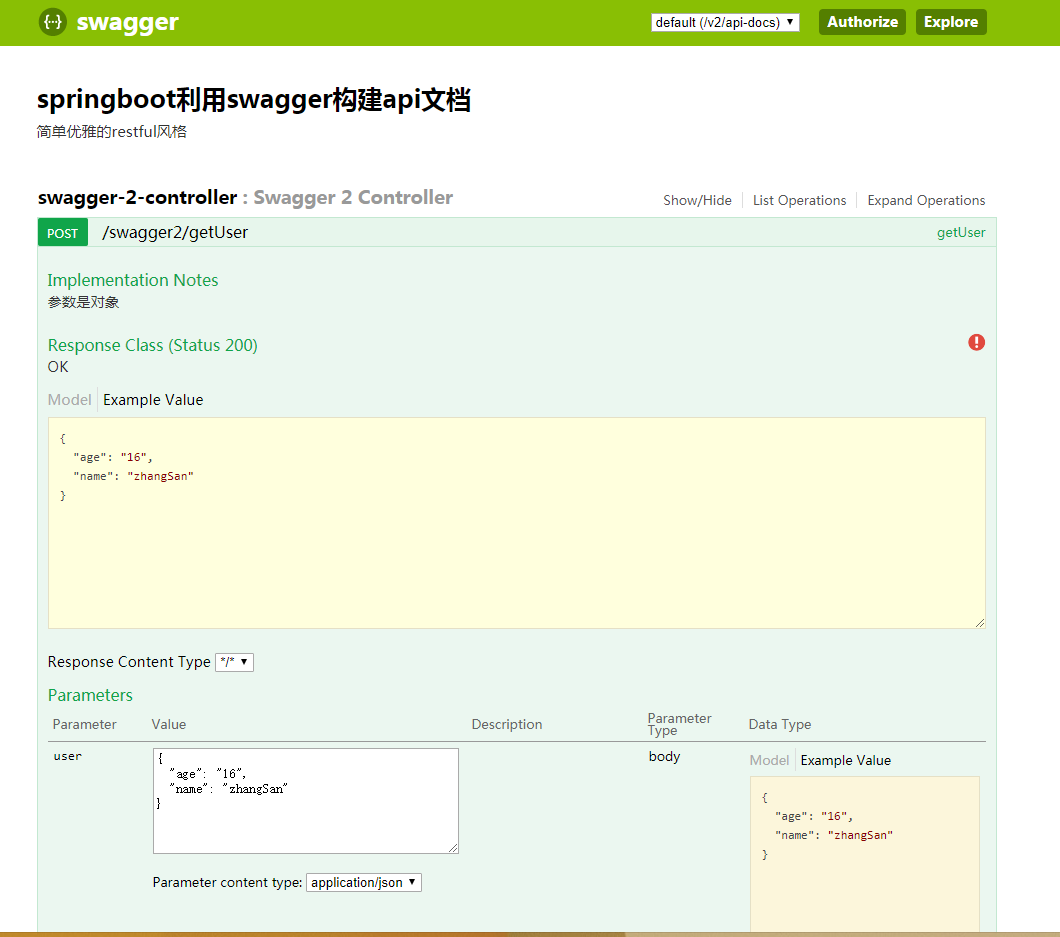1.引入jar
<!--引入swagger--> <dependency> <groupId>io.springfox</groupId> <artifactId>springfox-swagger2</artifactId> <version>2.7.0</version> </dependency> <dependency> <groupId>io.springfox</groupId> <artifactId>springfox-swagger-ui</artifactId> <version>2.7.0</version> </dependency>
swaggerConfig.注解使用
import io.swagger.annotations.ApiOperation; import org.springframework.context.annotation.Bean; import org.springframework.context.annotation.Configuration; import springfox.documentation.builders.ApiInfoBuilder; import springfox.documentation.builders.ParameterBuilder; import springfox.documentation.builders.PathSelectors; import springfox.documentation.builders.RequestHandlerSelectors; import springfox.documentation.schema.ModelRef; import springfox.documentation.service.*; import springfox.documentation.spi.DocumentationType; import springfox.documentation.spi.service.contexts.SecurityContext; import springfox.documentation.spring.web.plugins.Docket; import springfox.documentation.swagger2.annotations.EnableSwagger2; import java.util.ArrayList; import java.util.List; @Configuration @EnableSwagger2 public class SwaggerConfig { @Bean public Docket createRestApi() { return new Docket(DocumentationType.SWAGGER_2) .apiInfo(apiInfo()) .select() .apis(RequestHandlerSelectors.withMethodAnnotation(ApiOperation.class)) .paths(PathSelectors.any()) .build() .securitySchemes(securitySchemes()) .securityContexts(securityContexts()); } private ApiInfo apiInfo() { return new ApiInfoBuilder() .title("springboot利用swagger构建api文档") .description("简单优雅的restful风格") .termsOfServiceUrl("") .version("1.0") .build(); } private List<ApiKey> securitySchemes() { List<ApiKey> apiKeys = new ArrayList<>(); apiKeys.add(new ApiKey("Authorization", "Authorization", "header")); return apiKeys; } private List<SecurityContext> securityContexts() { List<SecurityContext> securityContexts = new ArrayList<>(); securityContexts.add(SecurityContext.builder() .securityReferences(defaultAuth()) .forPaths(PathSelectors.regex("^(?!auth).*$")).build()); return securityContexts; } private List<SecurityReference> defaultAuth() { AuthorizationScope authorizationScope = new AuthorizationScope("global", "accessEverything"); AuthorizationScope[] authorizationScopes = new AuthorizationScope[1]; authorizationScopes[0] = authorizationScope; List<SecurityReference> securityReferences = new ArrayList<>(); securityReferences.add(new SecurityReference("Authorization", authorizationScopes)); return securityReferences; } }
3注解使用
import io.swagger.annotations.ApiImplicitParam; import io.swagger.annotations.ApiImplicitParams; import io.swagger.annotations.ApiOperation; import org.springframework.web.bind.annotation.PostMapping; import org.springframework.web.bind.annotation.RequestBody; import org.springframework.web.bind.annotation.RequestMapping; import org.springframework.web.bind.annotation.RestController; @RestController @RequestMapping("/swagger2") public class Swagger2Controller { @PostMapping("/hello") @ApiOperation(value = "hello",notes = "一个参数") @ApiImplicitParam(name = "name",paramType = "query",defaultValue = "lisi") public String hello(String name){ return "hello "+name; } @PostMapping("/info") @ApiOperation(value = "info",notes = "两个参数") @ApiImplicitParams({ @ApiImplicitParam(name = "name",paramType = "query",defaultValue = "lisi"), @ApiImplicitParam(name = "age",paramType = "query",defaultValue = "15") }) public String info(String name,String age){ return "hello "+name+", age:"+age; } @PostMapping("/getUser") @ApiOperation(value = "getUser",notes = "参数是对象,返回值是对象") @ApiImplicitParam(name = "user",paramType = "body",dataType = "User") public User getUser(@RequestBody User user){ return user; } }
user实体类
import io.swagger.annotations.ApiModelProperty; import lombok.Data; @Data public class User { @ApiModelProperty(value = "姓名",example = "zhangSan") String name; @ApiModelProperty(value = "年龄",example = "16") String age; }
效果
note: lisi是默认值

